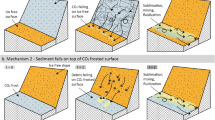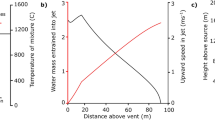Abstract
Liquid water may exist on the Martian surface today, albeit transiently and in a metastable state under the low atmospheric surface pressure1,2. However, the identification of liquid water on Mars from observed morphological changes is hampered by our limited understanding of how metastable liquids interact with sediments. Here, we present lab experiments in which a block of ice melts and seeps into underlying sediment, and the resulting downslope fluid propagation and sediment transport are tracked. In experiments at Martian surface pressure, we find that pure water boils as it percolates into the sediment, inducing grain saltation and leading to wholesale slope destabilization: a hybrid flow mechanism involving both wet and dry processes. For metastable brines, which are more stable under Martian conditions than pure water, saltation intensity and geomorphological impact are reduced; however, we observed channel formation in some briny flow experiments that may be analogous to morphologies observed on Mars. In contrast, under terrestrial-like experimental conditions, there is little morphological impact of seeping water or brine, which are both stable. We propose that the hybrid flow mechanism operating in our experiments under Martian surface pressure could explain observed Martian surface changes that were originally interpreted as the products of either dry or wet processes.
This is a preview of subscription content, access via your institution
Access options
Subscribe to this journal
Receive 12 print issues and online access
$259.00 per year
only $21.58 per issue
Buy this article
- Purchase on Springer Link
- Instant access to full article PDF
Prices may be subject to local taxes which are calculated during checkout




Similar content being viewed by others
Change history
04 May 2016
In the version of the Letter originally published, in Fig. 4b, the image number and coordinates were incorrect and the caption should have read 'Slope streaks (HiRISE image: ESP_035028_1685, centre coordinates: 11.5° S, 290.3° E)'. This has been corrected in all versions of the Letter.
References
Hecht, M. H. Metastability of liquid water on Mars. Icarus 156, 373–386 (2002).
Grimm, R. E., Harrison, K. P. & Stillman, D. E. Water budgets of Martian recurring slope lineae. Icarus 233, 316–327 (2014).
Brass, G. W. Stability of brines on Mars. Icarus 42, 20–28 (1980).
Chevrier, V. F. & Rivera-Valentin, E. G. Formation of recurring slope lineae by liquid brines on present-day Mars. Geophys. Res. Lett. 39, L21202 (2012).
Martinez, G. M. & Renno, N. O. Water and brines on Mars: current evidence and implication for MSL. Space Sci. Rev. 175, 29–51 (2013).
Ojha, L. et al. Spectral evidence for hydrated salts in recurring slope lineae on Mars. Nature Geosci. 8, 829–832 (2015).
McEwen, A. S. et al. Seasonal flows on warm Martian slopes. Science 333, 740–743 (2011).
McEwen, A. S. et al. Recurring slope lineae in equatorial regions of Mars. Nature Geosci. 7, 53–58 (2014).
Stillman, D. E., Michaels, T. I., Grimm, R. E. & Harrison, K. P. New observations of Martian southern mid-latitude recurring slope lineae (RSL) imply formation by freshwater surface flows. Icarus 233, 328–341 (2014).
Gough, R. V., Chevrier, V. F., Baustian, K. J, Wise, M. E. & Tolbert, M. A. Laboratory studies of perchlorate phase transitions: support for metastable aqueous perchlorate solutions on Mars. Earth Planet. Sci. Lett. 312, 371–377 (2011).
Kereszturi, Á. et al. Recent rheologic processes on dark polar dunes of Mars: driven by interfacial water? Icarus 201, 492–503 (2009).
Conway, S. J., Lamb, M. P., Balme, M. R., Towner, M. C. & Murray, J. B. Enhanced runout and erosion by overland flow at low-pressure and sub-freezing conditions: experiments and application to Mars. Icarus 211, 443–457 (2011).
Jouannic, G. et al. Laboratory simulation of debris flows over sand dunes: insights into gully-formation (Mars). Geomorphology 231, 101–115 (2015).
Haberle, R. M. et al. Preliminary interpretation of the REM pressure data from the first 100 sols of the MSL mission. J. Geophys. Res. 119, 440–453 (2014).
Massé, M. et al. Spectroscopy and detectability of liquid brines on Mars. Planet. Space Sci. 92, 136–149 (2014).
Chevrier, V. F., Ulrich, R. & Altheide, T. S. Viscosity of liquid ferric sulfate solutions and application to the formation of gullies on Mars. J. Geophys. Res. 114, E06001 (2009).
Atwood-Stone, C. & McEwen, A. S. Avalanche slope angles in low-gravity environments from active Martian sand dunes. Geophys. Res. Lett. 40, 2929–2934 (2013).
Kreslavsky, M. A. & Head, J. W. Slope streaks on Mars: a new ‘wet’ mechanism. Icarus 201, 517–527 (2009).
Malin, M. C. & Edgett, K. S. Evidence for recent groundwater seepage and surface runoff on Mars. Science 288, 2330–2335 (2000).
Möhlmann, D. & Kereszturi, A. Viscous liquid film on dune slopes of Mars. Icarus 207, 654–658 (2010).
Dundas, C. M., Diniega, S. & McEwen, A. S. Long-term monitoring of Martian gully formation and evolution with MRO/HiRISE. Icarus 251, 244–263 (2015).
Sullivan, R., Thomas, P., Veverka, J., Malin, M. & Edget, K. S. Mass movement slope streaks imaged by the Mars Orbiter Camera. J. Geophys. Res. 106, 23607–23633 (2001).
Hansen, C. et al. Seasonal erosion and restoration of Mars’ northern polar dunes. Science 331, 575–578 (2011).
Chojnacki, M. et al. Active slopes of Valles Marineris—wind, water and gravity. Proc. 46th Lunar Planet. Sci. Conf. 2752 (2015).
Vincendon, M. Identification of Mars gully activity types associated with ice composition. J. Geophys. Res. 120, 1859–1879 (2015).
Appéré, T. et al. Winter and spring evolution of northern seasonal deposits on Mars from OMEGA on Mars Express. J. Geophys. Res. 116, E05001 (2011).
Jouannic, G. et al. Morphological and mechanical characterization of gullies in a periglacial environment: the case of the Russel Crater dune (Mars). Planet. Space Sci. 71, 38–54 (2014).
Cousin, A. et al. Composition of coarse and fine particles in Martian soils at Gale: a window into the production of soils. Icarus 249, 22–42 (2015).
Gendrin, A. et al. Sulfates in Martian layered terrains: the OMEGA/ Mars Express view. Science 307, 1587–1591 (2005).
Westoby, M. J., Brasington, J., Glasser, N. F., Hambrey, M. J. & Reynolds, J. M. ‘Structure-from-Motion’ photogrammetry: a low-cost, effective tool for geoscience applications. Geomorphology 179, 300–314 (2012).
Acknowledgements
This work has been funded by ‘Programme National de Planétologie’ and by the P2IO LabEx (ANR-10-LABX-0038) in the framework ‘Investissements d’Avenir’ (ANR-11-IDEX-0003-01) managed by the French National Research Agency (ANR). S.J.C. acknowledges funding from the Leverhulme Trust Grant RPG-397. Thorough advice and help from S. Le Mouélic and O. Bourgeois greatly improved the quality of this article. We thank W. Marra for insightful comments.
Author information
Authors and Affiliations
Contributions
The methodology and experimental set-up was conceived and designed by M.M., S.J.C. and J.G. with significant advice, help and technical support from M.R.P., K.P., A.M., V.C., M.R.B., L.O., F.C. and G.J. All data analysis was done by M.M. with significant feedback from S.J.C., J.G. and K.P. Data about current water ice location and deposition were provided by M.V. and F.P. Physical constraints and models were provided by J.G., S.J.C. and S.C. All authors contributed to discussion, interpretation and writing.
Corresponding author
Ethics declarations
Competing interests
The authors declare no competing financial interests.
Supplementary information
Supplementary Information
Supplementary Information (PDF 989 kb)
Supplementary Movies
Supplementary Movie 1 (MOV 3899 kb)
Supplementary Movies
Supplementary Movie 2 (MOV 2580 kb)
Supplementary Movies
Supplementary Movie 3 (MOV 3085 kb)
Supplementary Movies
Supplementary Movie 4 (MOV 1830 kb)
Supplementary Movies
Supplementary Movie 5 (MOV 1891 kb)
Supplementary Movies
Supplementary Movie 6 (MOV 1629 kb)
Rights and permissions
About this article
Cite this article
Massé, M., Conway, S., Gargani, J. et al. Transport processes induced by metastable boiling water under Martian surface conditions. Nature Geosci 9, 425–428 (2016). https://doi.org/10.1038/ngeo2706
Received:
Accepted:
Published:
Issue Date:
DOI: https://doi.org/10.1038/ngeo2706
This article is cited by
-
A deep groundwater origin for recurring slope lineae on Mars
Nature Geoscience (2019)
-
Discovery of recurring slope lineae candidates in Mawrth Vallis, Mars
Scientific Reports (2019)
-
Water induced sediment levitation enhances downslope transport on Mars
Nature Communications (2017)
-
Granular flows at recurring slope lineae on Mars indicate a limited role for liquid water
Nature Geoscience (2017)
-
Formation of recurring slope lineae on Mars by rarefied gas-triggered granular flows
Nature Geoscience (2017)



